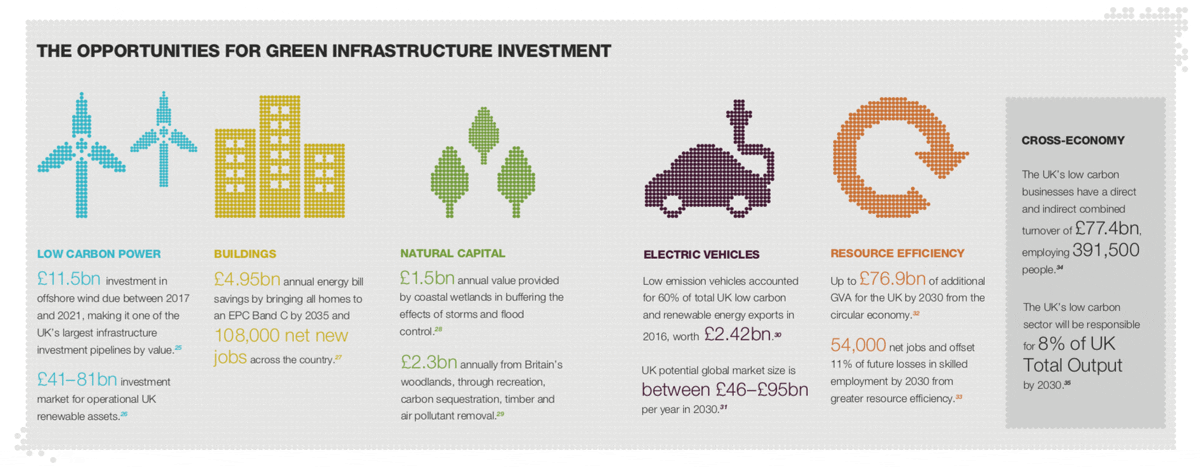TOWARDS THE NEW NORMAL—INCREASING INVESTMENT IN THE UK’S GREEN INFRASTRUCTURE
Strategic government intervention can maximise opportunities for private green infrastructure investment, our ‘Investing in the Future‘ project report with the Aldersgate Group finds, setting out a full list of recommendations for government and industry.
Executive Summary
Increasing private investment in green infrastructure presents huge opportunities for the UK. It offers a growing market for professional services and is a crucial way of reducing the cost of meeting the UK’s strategic and environmental policy objectives, securing more jobs, economic growth and export potential. We need to catalyse action on green infrastructure investment now to move the financial system towards the new normal.
There is real urgency: up to £693bn investment in low carbon infrastructure will be needed by 2031 in the UK and $90tn worldwide over the next 15 years. The ambitions within the government’s recently published policy strategies, including the Industrial Strategy (IS), Clean Growth Strategy (CGS) and 25 Year Environment Plan (25YEP) will need to be met with new and resilient infrastructure. This includes new and retrofitted energy efficient homes, infrastructure to manage increased risk of flooding, sustainable water and wastewater management, a nationwide network of electric vehicle (EV) charging points, low carbon heating solutions and significant new low carbon power generation. The majority of these needs will have to be met by private investment.
In setting up a Green Finance Taskforce (GFT) which was announced within the CGS, the UK government has recognised that increasing the flows of private green finance is essential to deliver the UK’s policy objectives and provides an opportunity to take a global leadership position. Coming a few weeks ahead of the Taskforce’s recommendations this report, which is based on a wide range of interviews with investors and businesses, considers the main barriers that are limiting investment and suggests key recommendations for government, business and investors to unlock greater volumes of private investment in green infrastructure. These provide a baseline to measure the strength of the government’s response to the Taskforce recommendations and long-term action on green finance.
The report’s recommendations consider low carbon energy generation, energy efficiency, natural capital and resource efficiency − all key areas for delivering the UK’s environmental and social goals. This report tackles the common structural barriers across these different types of infrastructure, echoing several findings of the EU’s High Level Expert Group on Sustainable Finance (HLEG) in the UK context.
Section I of the report first sets the scene for the UK’s green infrastructure investment needs and opportunities, before providing a brief overview of the financial system and its major stakeholders. Section II looks at what government can do to increase investment in green infrastructure, in particular: building project pipelines through policy stability and regulation; addressing structural market barriers such as short-termism; using public spending to incentivise private investment; improving access to data and high quality financial disclosure to inform investment strategies; and supporting innovative financial products to maximise the UK’s competitive advantage in green finance. Finally, we set out a full list of recommendations for government and industry to tackle as a priority.
→ Increasing investment in low carbon power
March 2018
→ Increasing investment in Natural capital
November 2017

